NIOS Class 10 Economics Chapter 10 Supply Solutions to each chapter is provided in the list so that you can easily browse through different chapters NIOS Class 10 Economics Chapter 10 Supply and select need one. NIOS Class 10 Economics Chapter 10 Supply Question Answers Download PDF. NIOS Study Material of Class 10 Economics Notes Paper 214.
NIOS Class 10 Economics Chapter 10 Supply
Also, you can read the NIOS book online in these sections Solutions by Expert Teachers as per National Institute of Open Schooling (NIOS) Book guidelines. These solutions are part of NIOS All Subject Solutions. Here we have given NIOS Class 10 Economics Chapter 10 Supply, NIOS Secondary Course Economics Solutions for All Chapters, You can practice these here.
Supply
Chapter: 10
MODULE 4: DISTRIBUTION OF GOODS AND SERVICES
TEXTBOOK QUESTIONS (SOLVED)
INTEXT QUESTIONS 10.1
Q.1. Define Supply.
Ans. Supply may be defined as the quantity of a commodity offered for sale at given price per unit of time.
Q.2. Name three elements included in the definition of supply.
Ans. Following are three elements included in the definition of supply:
(i) Price of the commodity.
(ii) Quantity supplied.
(iii) Time period.
Q.3. Distinguish between stock and supply.
Ans. Stock is the total quantity of a commodity available with a firm at a particular point of time whereas supply is that part of stock of a commodity that the seller is ready to sell at given price during a given period of time.
INTEXT QUESTIONS 10.2
Q.1. Draw a supply curve with the help of data given below:

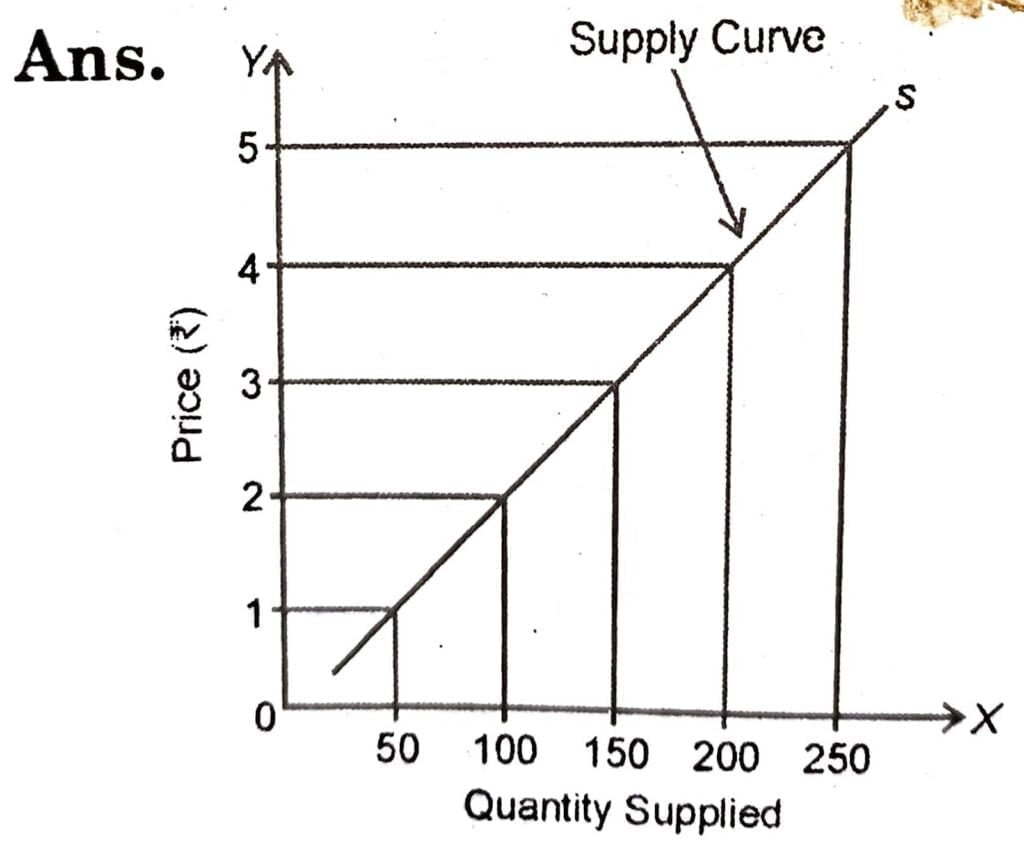
Q.2. Draw a supply curve by using following table i.e.

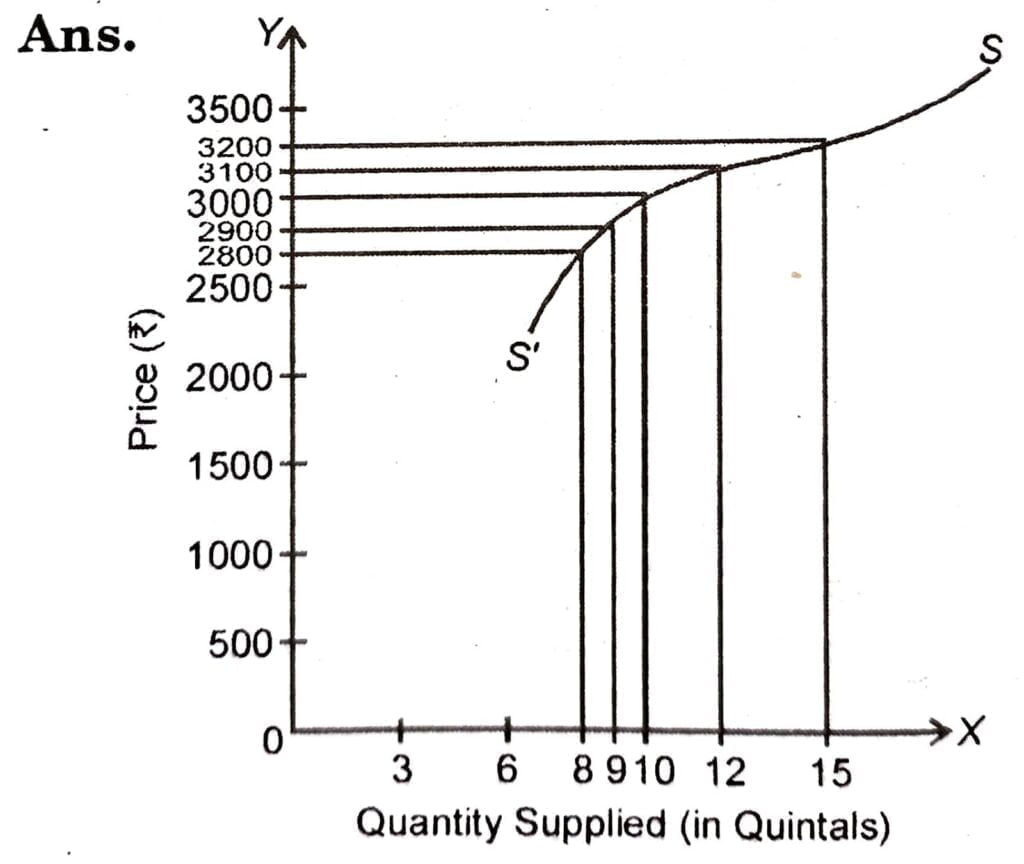
INTEXT QUESTIONS 10.3
Q.1. If there are only three firms A, B and C in the market supplying a commodity. Find out the market supply of the commodity, with the help of their supply schedules given below:

Ans.
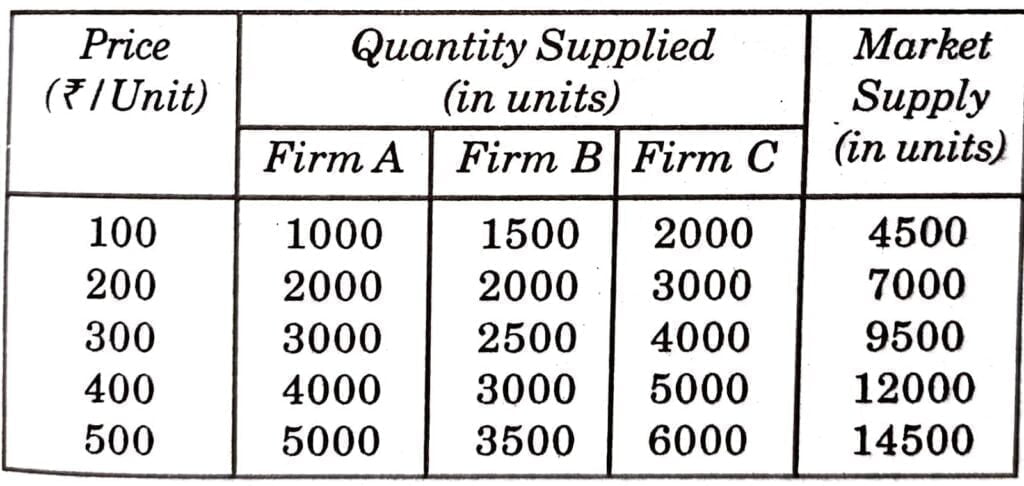
Q.2. Complete the following table (assuming that there are only three firms A, B and C in the market):
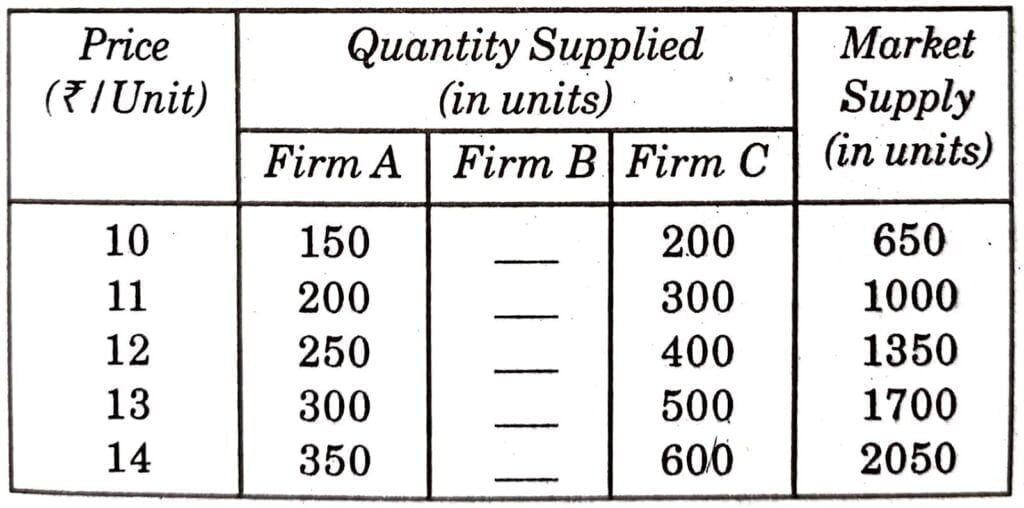
Ans.
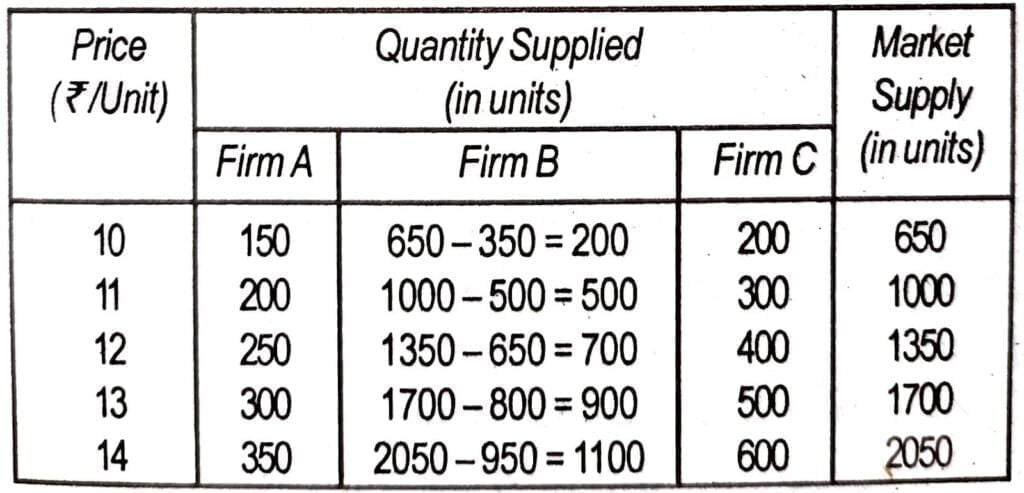
INTEXT QUESTIONS 10.4
Q.1. Fill in the blanks with appropriate words:
(i) Supply of a commodity ________ when its price increases.
Ans. Increase.
(ii) A firm having an objective of maximization of profit will supply ________ quantity of a commodity at a higher price.
Ans. More.
(iii) If a firm produces two goods X and Y with given resources and price of good Y falls, supply of good X will ________.
Ans. Increase.
(iv) A fall in wage rate will lead to ________ in supply of a commodity.
Ans. Increase.
(v) An increase in excise duty on production of TV set will ________ supply of T.V. sets.
Ans. Decrease.
Q.2. What will happen to the supply of a commodity, when
(i) The price of raw material used in the production of the commodity increases?
Ans. Supply of the commodity will decrease.
(ii) A new firm supplying the commodity comes into existence?
Ans. Supply of the commodity will increase.
(iii) There is technical progress?
Ans. Supply of the commodity will increase.
Q.3. What will happen to supply of stainless utensils if the price of stainless steel falls?
Ans. Supply of stainless steel utensils will increase.
TERMINAL EXERCISE
Q.1. Define supply. Distinguish between individual supply and market supply.
Ans. Supply may be defined as the quantity of a commodity that a seller/firm offers for sale at a given price per unit of time.
Difference between Individual Supply and Market Supply: Individual supply mean the supply of a commodity by an individual firm, whereas market supply is the total quantity of a commodity supplied by all the firms at a given price at a given line.
Q.2. Explain the factors which affect individual supply of a commodity.
Ans. Factors affecting Individual Supply of a Commodity: Following factors affect the individual supply of a commodity:
(i) Price of a Commodity: Higher the price of a commodity, higher the supply, lower the price of a commodity, lower will be the supply.
(ii) Prices of Other Factors of Production: If the prices of other factors of production rise this will cause the increase on the cost of production and shift the supply to the left. As such producers will prefer to invest their resources in those products in whose case the cost is relatively less. Thus the supply of the product will decline.
(iii) Level of Technology: Higher the level of technology, lower will be the cost of production, lower the cost higher will be the tendency of the supply to increase.
(iv) Government Policy: Government policy also determines the supply of a commodity. For example, if the government increases the rate of value added tax or sales tax on a commodity, it will increase the cost of production per unit which will decrease the supply of a commodity. On the other hand, a reduction in the tax on a commodity will decrease cost of production per unit and increase the supply of the commodity.
Q.3. Explain three determinants of market supply of a commodity in brief.
Ans. Factors determining Market Supply of a Commodity:
(i) Price of a Commodity: There is direct relationship between the price of a commodity and its supply. Higher the price of a commodity, higher the supply, lower the price of a commodity, lower will be the supply.
(ii) Number of Sellers: Market supply is an aggregate of all individual supply schedules in the market. Suppose there are three firms, in a market and they supply 100 kgs. of sugar daily at a given price. Suppose a new firm enters sugar in industry. It supplies 20 kg. of sugar daily. In this case supply of sugar will increase. Therefore it is clear that if number of firm increases, market supply will also increase. On the other hand, if number of firms decreases, the market supply will also decrease.
(iii) Expected Future Price: If the price of a commodity is expected to rise in the future, the firm will supply less quantity of the commodity at present in expectation of higher profit due to increase in profit in future.
Q.4. Distinguish between stock and supply with the help of a suitable example.
Ans. Distinction between Stock and Supply: The total quantity of a commodity available with a seller/firm at a particular point of time is called stock. On the other hand, supply is the part of stock of the commodity that the seller is ready to sell at some given price during a given time period. So supply is a flow. Stock is measured a particular point of time whereas supply is measured over a period of time.
Example: Suppose a merchant purchased 820 quintals on the first day of August, 2012. It was called stock on the 1st August, 2012. Here 1st August is the point of time at which the stock has been measured. During the month of August 2012, the merchant supplied ₹ 300 quintals of rice at ₹ 3000 per quintal. The supply of 300 quintals at the price of 3000 during August was the flow. Since there are 31 days in August, we measure it as a period of time during which the supply has been measured. Over these 31 days, the merchant sold some amount everyday which if added becomes 300 quintals at the end of that month at the given market price of ₹ 3,000. So supply is a part of the stock of the commodity.
Q.5. State and explain the law of supply using a suitable numerical example.
Ans. Law of Supply: The law of supply states that other things remaining the same, higher the price, the greater the quantity supplied or the lower the price, the smaller the quantity supplied. In other words, there is a positive relationship between the price of a commodity and its quantity supplied.
Law of supply can be explained with the help of a table:

From the table, we come to know that supply was 100 units when the price is ₹ 4. When the price increases from ₹ 4 to ₹ 5, supply increases from 100 units to 125 units and so on.
Q.6. What is supply curve? Draw an individual supply curve with the help of a hypothetical supply schedule.
Ans. Supply Curve: Supply curve is a diagrammatic representation of law of supply. Drawing an individual supply curve with the help of a given supply schedule:
Individual Schedule supply
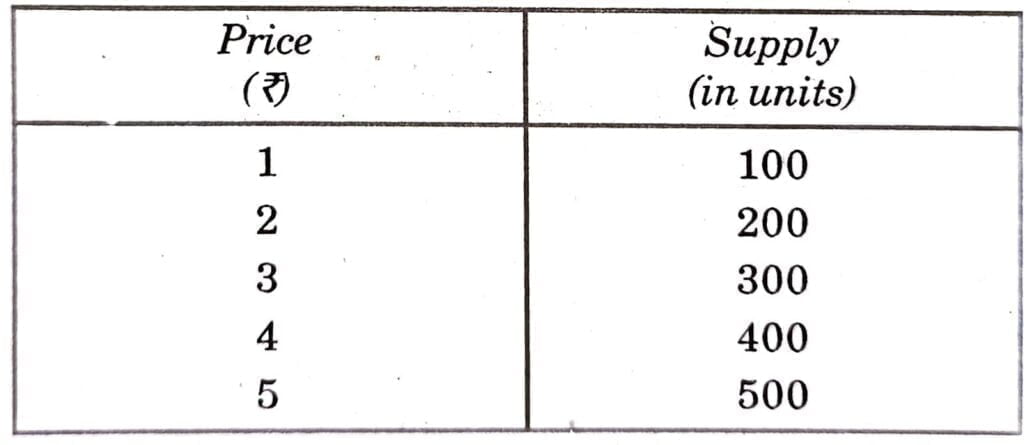
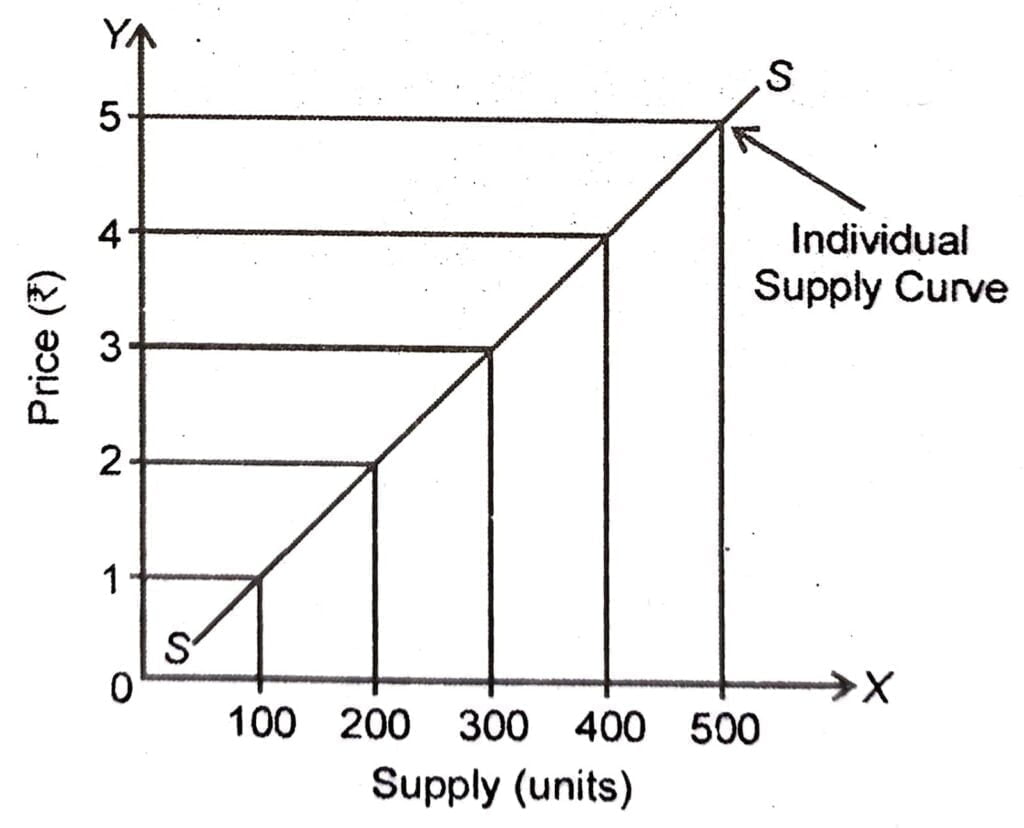
Q.7. Why does the supply curve slope upwards?
Ans. Following factors are responsible for upward slope of the supply curve:
(i) A rise in price of the commodity causes rise in profits. As a result firms are induced to supply more quantity of the commodity to increase profit.
(ii) A rise in price of a commodity induces the seller to dispose of at least a part of his stock. The reverse happens when there is fall in the price of a commodity.
(iii) An increase in the price of a commodity causing higher profit attract new firm to enter the market and this adds the supply of a commodity leading to more quantity supplied at a higher price.
Q.8. What are the reasons behind the law of supply?
Ans. The main reason behind the law of supply is the profit to be earned by the producer.
SOME IMPORTANT QUESTIONS FOR EXAMINATIONS
VERY SHORT ANSWER TYPE QUESTIONS
Q.1. Define supply of a commodity.
Ans. It is the quantity of a commodity which firm is willing to sell in the market in a given period of time at a given price.
Q.2. What are the factors on which the supply of commodity depends?
Ans. (i) The price of the commodity.
(ii) Goals of the firm.
(iii) The price of other commodities.
(iv) State of technology.
(v) Prices of factors of production.
(vi) Nature of commodity.
Q.3. What is meant by supply schedule?
Ans. Supply schedule expresses different quantities supplied by a firm at different prices.
Q.4. Define market supply schedule.
Ans. Market supply schedule refers to that schedule which shows different amounts of a commodity that all the sellers in a market are willing to sell at different prices of that commodity at a given time.
Q.5. What is supply curve?
Ans. It is graphical representation of the quantity supplied at different prices.
Q.6. What is individual supply curve?
Ans. It is a geometric expression of the individual supply It shows quantities of a commodity that a firm offers for sale at different possible prices of that commodity.
Q.7. What is the law of supply?
Ans. Law of supply expresses the relation between the price of a commodity and its supply. When price rises, supply extends and when price falls, supply contracts, other things being constant.
Q.8. What is normal shape of supply curve?
Ans. Normally it has positive shape.
Q.9. What do you understand by the market supply of a commodity?
Ans. Market supply of a commodity refers to the total quantity that is offered for sale by all the producing units at a particular price at a time. It is the sum of individual supply schedules for all those firms which are engaged in production of a given commodity during a given period of time.
Q.10. Give one point of difference between stock and supply.
Ans. Stock is measured at a particular point of time, whereas supply is measured over a period of time.
Q.11. Name any three factors which increase the supply.
Ans. (i) Improvement in technology.
(ii) Decrease in the price of inputs.
(iii) Reduction in the tax on the commodity.
Q.12. A farmer produces two goods wheat and rice with the help of given resources. The price of rice increases. What will the farmer do in this case and why?
Ans. The farmer will divert his resources from production of wheat to production of rice to produce more rice due to increase in the price of rice. It will be profitable for him to grow more rice.
Q.13. What will be the impact of decrease in the price of inputs on the supply of the goods?
Ans. Decrease in the prices of inputs will lead to increase the supply of good.
Q.14. How will the supply of ice cream affected by increase in the price of milk?
Ans. Supply of ice cream will fall.
Q.15. The information about the different quantities supplied at different prices is given in the table:
Supply Schedule
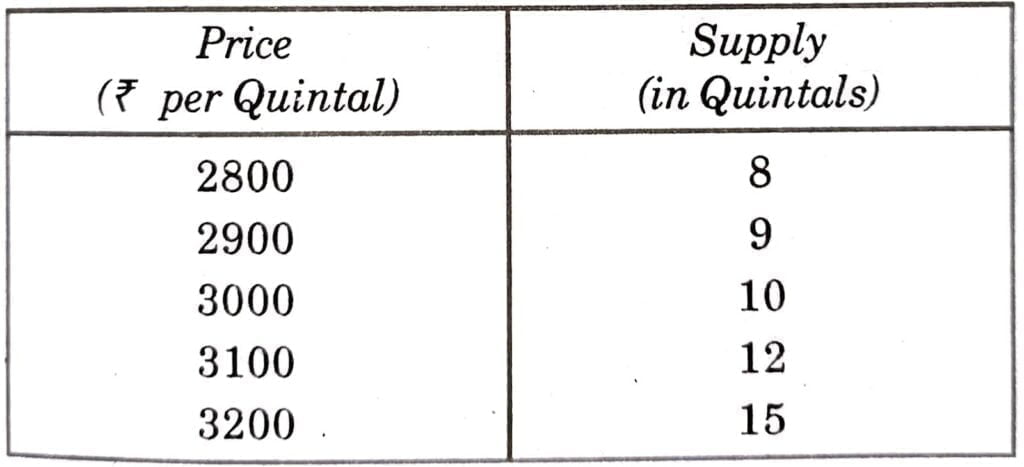
How much quintals of sugar will the producer supply at the price of ₹ 3100 per quintal?
Ans. 12 quintal of sugar will be supplied.
Q.16. Draw of supply curve.
Ans.
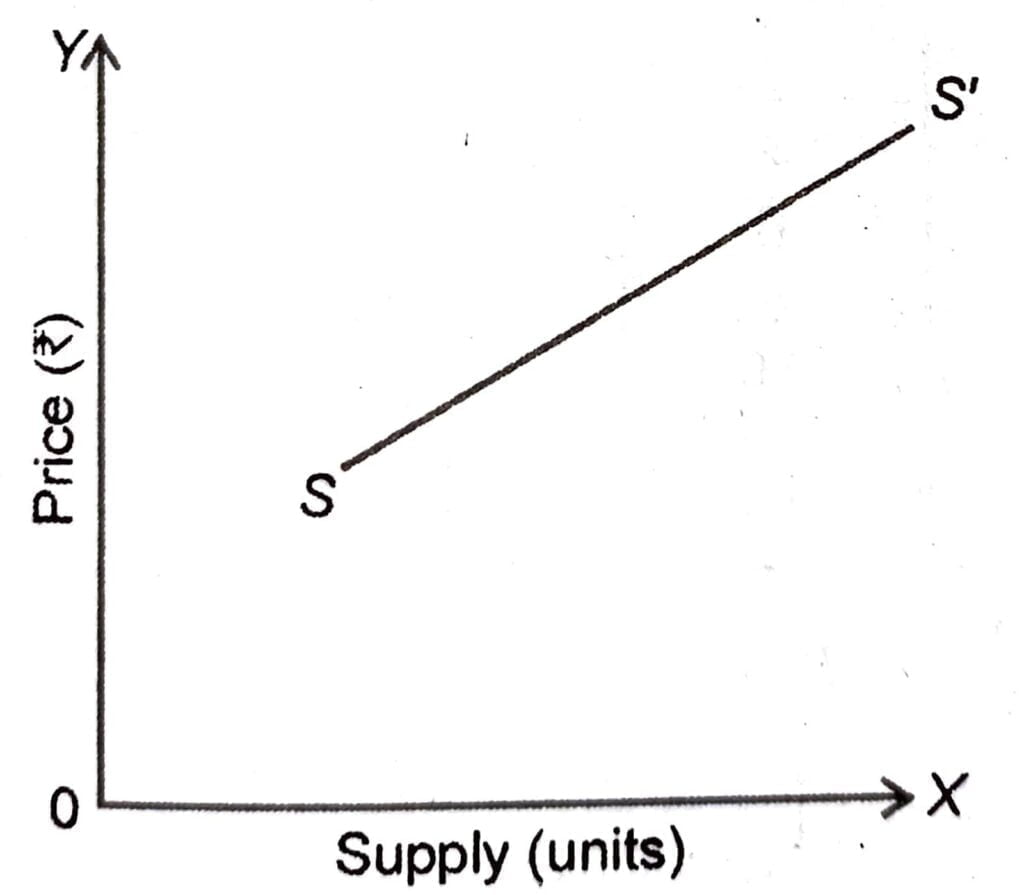
Q.17. Give any one factor responsible for upward slope of the supply curve.
Ans. Increase in profit due to a rise in the price of the commodity.
Q.18. Who attracts the new firms to enter the market?
Ans. An increase in the price of the commodity causing higher profit attracts the new firms to enter the market.
Q.19. How is supply of a commodity affected with the entry of new firms in the market?
Ans. Supply increases.
Q.20. How does the supply of a commodity behave when its price increases?
Ans. Supply of the commodity will increase.
Q.21. What will happen to the supply of a commodity when the price of raw material used in the output increases?
Ans. Supply will decrease.
Q.22. Excise duty on the production of TV set is increased. How will the supply of TV sets behave in this case?
Ans. Supply of TV sets will decrease.

Hi! my Name is Parimal Roy. I have completed my Bachelor’s degree in Philosophy (B.A.) from Silapathar General College. Currently, I am working as an HR Manager at Dev Library. It is a website that provides study materials for students from Class 3 to 12, including SCERT and NCERT notes. It also offers resources for BA, B.Com, B.Sc, and Computer Science, along with postgraduate notes. Besides study materials, the website has novels, eBooks, health and finance articles, biographies, quotes, and more.



